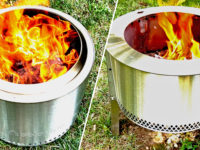WiFi that actually works.
Disclaimer: The folks at eero (owned by Amazon) generously provided us with an eero Pro 6 3-pack for this review. As always, the options below are my own.
Upgrading your home’s WiFi system probably isn’t at the top of your to-do list, but it might be one of the most impactful home improvements you can make in the world we’re living in now. With Lauren and I both working from home full time and the kids frequently Zooming for school, I can’t tell you how impactful even the smallest blip in our home network’s stability can be.
We’ve used a Linksys Velop mesh WiFi system for the past few years, and although it’s been fine, over time I’ve never felt like it lived up to the stability and speed we were promised on the box. Since Xfinity recently raised our download speeds to over 600 Mbps (not bad for cable!), I thought now would be a great time to check out the latest WiFi 6 technology.
I’ve heard nothing but good things about the eero whole home wireless system, so I was pumped when they sent over an eero Pro 6 3-pack for us to check out. Here are all of the cool things it promises to deliver:
- Full support for WiFi 6
- Gigabit WiFi speeds
- Whole home WiFi that covers up to 6000 sq ft
- Tri-band radio support to accommodate more than 75 devices
- A built-in smart home hub!
- Enhanced security with the optional eero Secure subscription
- … and even more features and upgrades over time!
Is it worth swapping out your own WiFi for an eero system? Read on to find out!

Setup
Let’s kick things off with a big statement… I’ve set up dozens of wireless routers over the last 15 years, and this eero system is without a doubt the easiest system I have ever installed. I literally had all 3 WiFi nodes set up in under 10 minutes (and probably 5 minutes of that time was just standing by while the system initialized).
In the box you’ll only find 3 eero nodes, an ethernet cable (if you need it), and the corresponding power plugs for each (yay for being small USB-C power bricks too). Download the eero app, plug in any of the nodes to your modem, and you’re off to the races. I honestly had my first devices latching onto eero’s WiFi in less than a minute, and then adding the remaining nodes was brainlessly easy.



On a side note here, I was a little worried about where to position my other nodes as my Velop system seemed to be pretty picky about location (occasionally even dropping a node every few months). I started off by positioning my nodes exactly the same as with the Velop, and the eero nodes connected right away without issue; they definitely seem to communicate better between each other than the Velop nodes.
Look and Feel
Look and feel probably isn’t far up on your list as far as routers are concerned, but I love how nondescript (and low profile!) the eero Pro 6 nodes are. They’re white, sleek, about 3 inches tall at their peaks, and completely… well… unnoticeable. The Velop nodes weren’t ugly by any stretch of the imagination, but even those drove Lauren crazy sitting on our mantle. She definitely prefers the eero sitting up there instead.

Also, although the eero nodes feature a bright status light at the front, you can toggle these off on a per-node basis in the eero app. Easy-peasy.
Performance and User Experience
Performance is probably all you really care about when it comes to routers, and let me tell you, the eero Pro 6 delivers. Like, night and day delivers.
Now, home wireless routers make a lot of claims in regards to performance and bandwidth, and I’ve learned to take those with a giant grain of salt. What I’ve come to expect is about 200 Mbps download speeds on a good day (no matter how fast your core internet connection is out of the modem) as long as you’ve got complete line of sight with a node and are about 20 ft away. That’s about how our Velop performed over time, so I figured that any improvement on that would be a win.
What I didn’t expect was such a huge improvement right away. Holy cow, guys.
Long story short, by upgrading to the eero Pro 6, I immediately saw my download speeds triple in most scenarios, and double everywhere else. The middle of my living room jumped to 304 Mbps down (up from 104 with the Velop). My bonus room shot up to 655 Mbps down (up from 173 before). Even my upstairs bathroom that seems to be a WiFi black hole doubled its download speeds to 50 Mbps down (where it struggled to get over 20 before). That’s a crazy improvement.
Living Room Speeds (Left: Velop, Right: eero)

Bonus Room Speeds (Left: Velop, Right: eero)

Bathroom (WiFi Black Hole) Speeds (Left: Velop, Right: eero)

Now, the eero app features a ton of extra features, which if I’m honest, I’ll probably never use. For free, eero features some awesomely simple bandwidth monitoring tools, guest network access, and most of the advanced WiFi configuration tools that nerds will look for (like custom DNS and port forwarding). If you don’t mind a reasonably priced subscription, you can also grab some extra security features with the eero Secure service like malware prevention, ad blocking, and even parental controls. We already use other services for features like these, but if you’re looking for an all-in-one solution, eero’s offerings here look pretty compelling.

One final feature to note here: the eero Pro 6 line also includes a built-in smart home hub feature which might be pretty great if you don’t already have a way you’re controlling your devices. It only works with WiFi devices and devices that use a Zigbee radio (so no support for Z-Wave), but if you’re linking your WiFi to your Amazon account and want to work up some magic with Alexa-based voice control throughout your home, eero’s built-in hub will be a great value-add for you.
Reliability
After doing dozens of speed tests and watching our network breathe a little with eero over time, I couldn’t be more happy with the reliability that the eero Pro 6 system has offered throughout our home. All of our devices stay connected consistently, and they seem to do a much better job of connecting to the closest node than they did with our Velop system.
More importantly, our speeds have stayed blazing fast every time I test them. This is the first time in a while that I don’t find myself thinking about my WiFi or wondering if I’m connected to the fastest node during work hours. Everything just works.
Affordability
The affordability of the eero Pro 6 system has a lot to do with the size of your home. Live in an apartment or a smaller home? The 1-pack is a great solution that doesn’t break the bank at $229. If you live in a bigger home, the 3-pack’s $599 price point may seem high, but I promise that it has been worth every penny in my testing. This is especially true if you find yourself renting networking gear from your ISP; investing in high quality networking equipment like this up front is well worth the price.
Conclusion
If you’re looking for the fastest WiFi for your home with the least headache to set it up and keep it going, the eero Pro 6 system is absolutely the system you’re looking for. While it may not offer the highly technical configuration options of some competitors or the biggest radio array, eero will get killer WiFi 6 speeds to even the furthest reaches of your house. It’s the best WiFi out there for 95% of homes.

















Since Xfinity recently,.. raised our download speeds to over 600 Mbps…
Really a cool gadget which will be in use for office work and schools especially in this pandemic where most of the people are working from home and need quality internet with the best wifi. I think many people’s search ends here on this product.
Wow these devices are so adorable and loved they was they were designed. And the working features of them are so good that any user needs only this kind of things I would say. I really wanna get them for my home.
This seems very suitable for every apartment as well. Thanks for sharing with us.
Hi there, You have performed a great job. I will certainly digg it and individually suggest to my friends. I’m confident they’ll be benefited from this website.
This is the first time in a while that I don’t find myself thinking about my WiFi or wondering if I’m connected to the fastest node during work hours.
This seems very suitable for every apartment as well. Thanks for sharing with us.
As a result, before employing any best essay writing service provider, consider the following factors.
What? Are you still playing this old game? Oh my God. Come! Much more entertaining gambling games were developed on the Internet. And you can win them all! Finally, you can make sports betting as a completely new way to win money online https://drbetcasino.co.uk/ . Just sign up to get your promo code and place your bet.
Great review! the Pro 6 sounds like a great upgrade. I currently have the OG eero system close to when it first came out back in 2014, I’ve just moved in to a new home that’s larger than my old one and I’m definitely feeling that it’s not quite adequate for covering it in Wi-Fi. Would you have any advice on whether I’d be better off expanding my existing eero system, or upgrading to the Pro 6? I must say the speed uplift and built-in smart home hub are awfully tempting!
The eero Pro 6 Whole-Home WiFi System is an all-in-one home WiFi solution that provides coverage throughout your home. The eero Pro 6 Whole-Home WiFi System features a powerful 6-core processor and offers up to 3x the performance of our previous model.
Click Here: https://roofingcontractorusa.com/expert-roofing/best-roofing-repair-services-in-mississippi-city-ms/ Residential Roofing installation services in Mississippi city ms
I also use Linksys Velop mesh WiFi system in my office, which is an excellent WIFI system.
Visit here: https://carpetdyepro.com/rug-restoration-services-in-concord-north-carolina/ Rug Restoration Services in North Carolina
It’s good home wifi with affordable price. I will buy additional eero to give my close friend this birthday.
Your post was interesting to read and I found it to be quite useful. Thank you so muchh
SBF doesn’t need SPF where he’s going
The Quordle game is four times as challenging as Wordle, requiring you to predict all four words in a given phrase within nine trials.